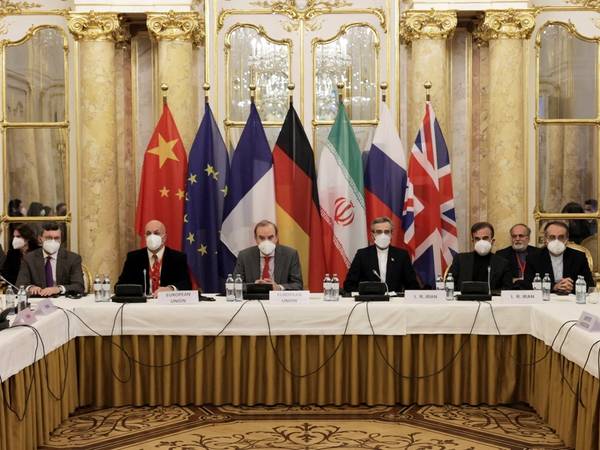Data released by Tehran show the economy has grown more than 4 percent over the last year, driven by high oil prices and loose enforcement of U.S. sanctions.
This relatively strong economic growth can partially explain Tehran’s current stonewalling of nuclear negotiations with the Biden administration, as Supreme Leader Ali Khamenei likely does not feel massive pressure to secure sanctions relief by striking a deal. If Washington were to reinvigorate its sanctions enforcement, however, it could reverse the Islamic Republic’s economic fortunes, stoke political instability within Iran, and pressure Khamenei to surrender.
According to Iran’s Statistics Center, the country’s GDP grew by 4.3 percent during the Persian calendar year 1400 (April 2021 to March 2022). The growth rate in the previous year was one percent. Almost all major sectors of the economy grew. Oil and gas saw the fastest growth rate, at 9.7 percent. The service sector, the largest sector of Iran’s economy, grew by 4.5 percent after having shrunk by 1.3 percent the previous year. This growth, however, does not mean that the economy is doing well. The real GDP is still below its March 2018 level, the point-to-point inflation was 52.5 percent in June, and the country faces daily protests and strikes over low wages and high inflation.
Several factors explain this higher growth. First, since taking office in January 2021, President Joe Biden has abandoned his predecessor’s policy of “maximum pressure” against Iran, leading to loose enforcement of U.S. sanctions against the Islamic Republic. Iran exported $48 billion worth of non-oil goods during the Persian year of 1400, the most in the country’s history. This trend has continued throughout the first two months of 1401 (April and May 2022), during which time Tehran exported 40 percent more oil year-over-year.
Meanwhile, Iran’s economy has benefited from higher prices of commodities, particularly oil and oil-based goods such as petrochemicals. The Islamic Republic also managed to replace some imported goods by expanding domestic production, in turn boosting Iran’s manufacturing and mining sectors. Finally, the removal of pandemic-related restrictions, combined with public optimism about reaching a deal with the United States to end sanctions, contributed to the growth in the service sector.
Iran’s renewed economic growth likely helps explain why Khamenei is in no rush to reach a nuclear deal with Biden. Loose U.S. sanctions enforcement has allowed Khamenei to reap economic benefits while expanding his nuclear program and eroding Washington’s leverage over Tehran.
Fortunately for the United States, however, Iran’s economy — and thus Khamenei’s negotiating position — remains fragile. If oil prices remain high and U.S. sanctions enforcement remains lackluster, the Islamic Republic could probably achieve 3to 5 percent growth this year. But a U.S. return to “maximum pressure” would likely see Iran’s economy return to meager or negative growth rates.
One sign of this fragility is that Iranian economic growth decelerated toward the end of the year, with GDP growing by just 2.3 percent during the last quarter (spring of 2022) compared to 6.9 percent during the first quarter (winter of 2021). That trend held true across most economic sectors. For example, whereas the oil and gas sector grew by 27.4 percent in the first quarter, its growth rate dropped to 0.5 percent in the fourth quarter. Likewise, the real estate sector grew 15.3 percent in the first quarter but shrank by 3.4 percent in the last quarter.
Moreover, the Islamic Republic has suffered from high inflation since late 2018, reducing purchasing power. This means that domestic consumption and demand are fragile. If the Biden administration tightens sanctions enforcement, consumer and investor pessimism will push down investment and consumption. The result will be a slowdown in economic activity and lower or negative GDP growth.
That economic downturn could exacerbate Iran’s ongoing socio-political instability, toppling his regime or increasing Khamenei’s incentive to reach a deal with Washington. Since 2017, the country has faced two waves of massive protests. In November 2019, the regime killed at least 1,500 protesters in less than a week to survive the most widespread protests of its history. Government restrictions and self-imposed isolation during COVID-19 slowed down the protests, but as those impediments faded, protests and worker strikes began again in 2021 and gained momentum in 2022. The protests and strikes now occurring daily across Iran reflect deep societal discontent, which can both signal and create economic troubles.
If the Biden administration continues with the status quo, it can expect Tehran to continue stonewalling, eliminating any chance of reaching an acceptable nuclear deal. Conversely, reviving maximum pressure could force Khamenei to play ball. With the Islamic Republic edging closer and closer toward a nuclear weapon, Biden doesn’t have any time
Saeed Ghasseminejad, who contributed this opinion article is a senior advisor on Iran and financial economics at the Foundation for Defense of Democracies (FDD), where he contributes to FDD’s Iran Program and Center on Economic and Financial Power (CEFP). Follow Saeed on Twitter @SGhasseminejad. FDD is a Washington, DC-based, non-partisan research institute focusing on national security and foreign policy.
The opinions expressed by the author are not necessarily the views of Iran International.
